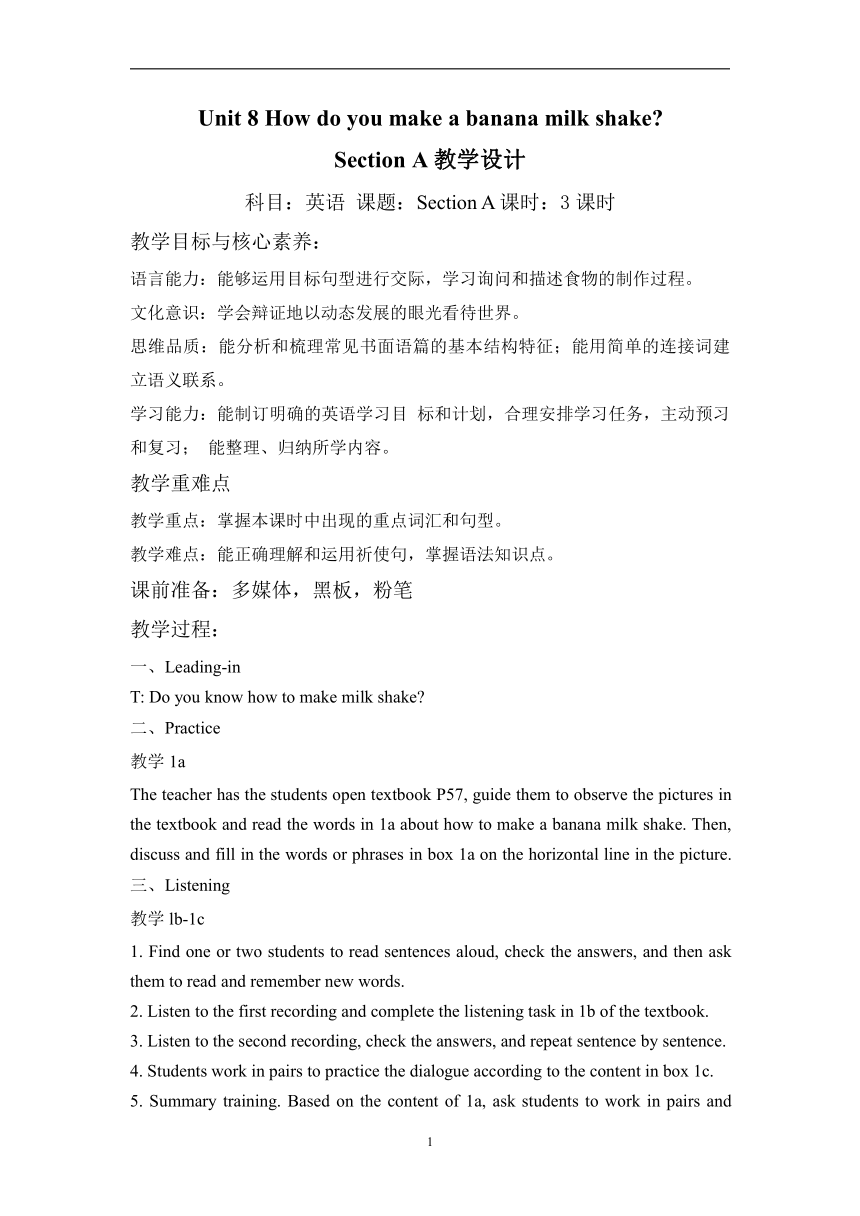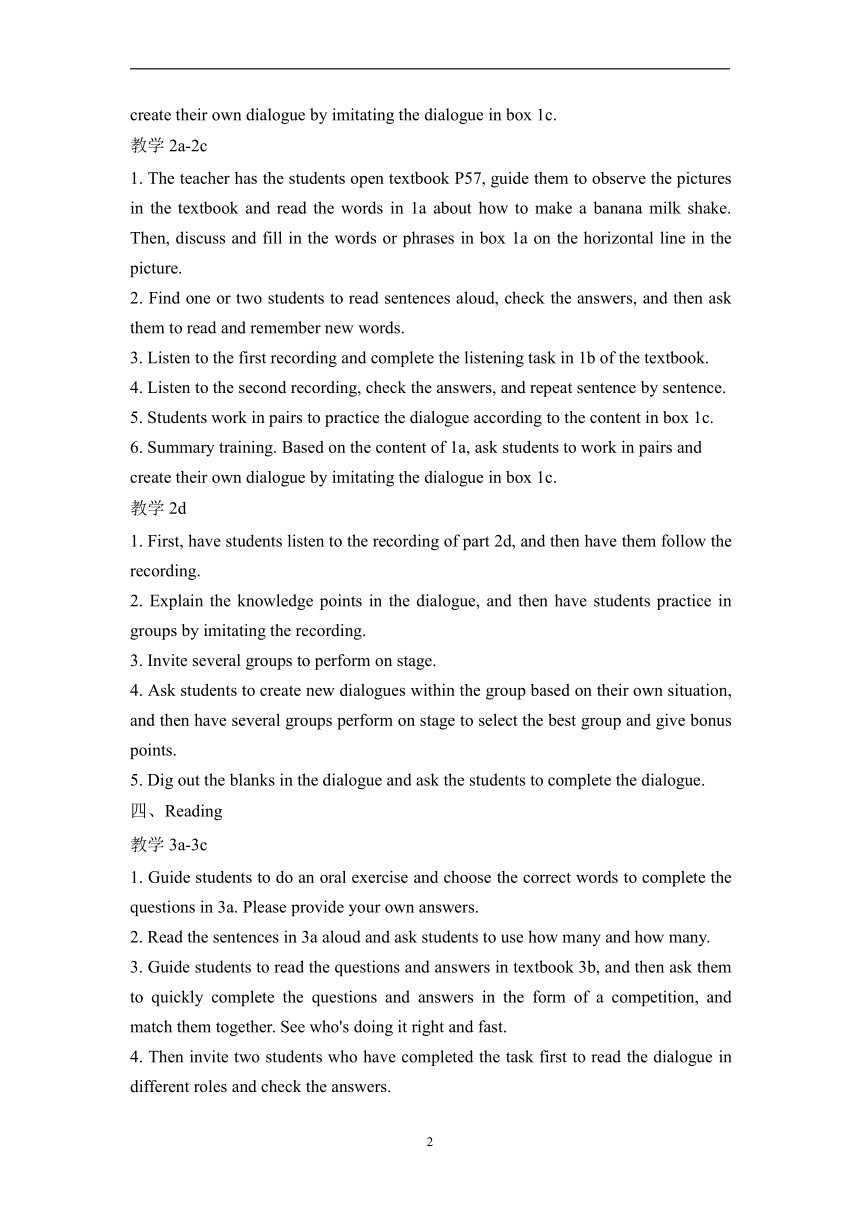Unit 8 How do you make a banana milk shake Section A 教案人教版八年级上册
文档属性
| 名称 | Unit 8 How do you make a banana milk shake Section A 教案人教版八年级上册 |  | |
| 格式 | docx | ||
| 文件大小 | 28.9KB | ||
| 资源类型 | 教案 | ||
| 版本资源 | 人教新目标(Go for it)版 | ||
| 科目 | 英语 | ||
| 更新时间 | 2023-11-13 22:04:25 | ||
图片预览


文档简介
Unit 8 How do you make a banana milk shake
Section A教学设计
科目:英语 课题:Section A 课时:3课时
教学目标与核心素养:
语言能力:能够运用目标句型进行交际,学习询问和描述食物的制作过程。
文化意识:学会辩证地以动态发展的眼光看待世界。
思维品质:能分析和梳理常见书面语篇的基本结构特征;能用简单的连接词建立语义联系。
学习能力:能制订明确的英语学习目 标和计划,合理安排学习任务,主动预习和复习; 能整理、归纳所学内容。
教学重难点
教学重点:掌握本课时中出现的重点词汇和句型。
教学难点:能正确理解和运用祈使句,掌握语法知识点。
课前准备:多媒体,黑板,粉笔
教学过程:
Leading-in
T: Do you know how to make milk shake
二、Practice
教学1a
The teacher has the students open textbook P57, guide them to observe the pictures in the textbook and read the words in 1a about how to make a banana milk shake. Then, discuss and fill in the words or phrases in box 1a on the horizontal line in the picture.三、Listening
教学lb-1c
1. Find one or two students to read sentences aloud, check the answers, and then ask them to read and remember new words.
2. Listen to the first recording and complete the listening task in 1b of the textbook.
3. Listen to the second recording, check the answers, and repeat sentence by sentence.
4. Students work in pairs to practice the dialogue according to the content in box 1c.
5. Summary training. Based on the content of 1a, ask students to work in pairs and create their own dialogue by imitating the dialogue in box 1c.
教学2a-2c
1. The teacher has the students open textbook P57, guide them to observe the pictures in the textbook and read the words in 1a about how to make a banana milk shake. Then, discuss and fill in the words or phrases in box 1a on the horizontal line in the picture.
2. Find one or two students to read sentences aloud, check the answers, and then ask them to read and remember new words.
3. Listen to the first recording and complete the listening task in 1b of the textbook.
4. Listen to the second recording, check the answers, and repeat sentence by sentence.
5. Students work in pairs to practice the dialogue according to the content in box 1c.
6. Summary training. Based on the content of 1a, ask students to work in pairs and create their own dialogue by imitating the dialogue in box 1c.
教学2d
1. First, have students listen to the recording of part 2d, and then have them follow the recording.
2. Explain the knowledge points in the dialogue, and then have students practice in groups by imitating the recording.
3. Invite several groups to perform on stage.
4. Ask students to create new dialogues within the group based on their own situation, and then have several groups perform on stage to select the best group and give bonus points.
5. Dig out the blanks in the dialogue and ask the students to complete the dialogue.
四、Reading
教学3a-3c
1. Guide students to do an oral exercise and choose the correct words to complete the questions in 3a. Please provide your own answers.
2. Read the sentences in 3a aloud and ask students to use how many and how many.
3. Guide students to read the questions and answers in textbook 3b, and then ask them to quickly complete the questions and answers in the form of a competition, and match them together. See who's doing it right and fast.
4. Then invite two students who have completed the task first to read the dialogue in different roles and check the answers.
5. Require students to discuss the content in 3c in groups, write down the production process, and present it as a group.
6. Evaluate the different production programs displayed by each group and praise the outstanding ones in the class.
五、Language Points
1.Turn on the blender.打开食物搅拌器
要点精析
这是一个祈使句。祈使句用来表示请求、命令、劝告、建议等。祈使句的主语一般为第二人称 you,但往往可以省略。祈使句的谓语用动词原形。否定的祈使句通常用 don't开头。
例:Come and look at the picture.来看看这幅图画
Don't eat anything in class.不要在课堂上吃东西
2. Pour the milk into the blender.将牛奶倒入食物搅拌器
要点精析
pour...into..意为“将......倒人......"。into 为介词,意为“到......里面进入”
例: Please pour the water into the bowl. 请把水倒入碗中
知识拓展
into意为“到......里面;进入”,是表示动态的介词;in 意为“在......内”,是表示静态的介词。
例:She walkedinto the room.她走进了房间
Sheis walkingin the room.她正在房间里走来走去
在 put,throw,break,fall 等动词之后,既可以用in,也可以用into,这时in 也表示动态,常含有into 的意思。
例: He put all the books in/into the bag. 他把所有的书都放进了书包里
in 可以用作副词,into 则不能
例:Come in!进来!
3.How do you make a banana milk shake 你怎样做香奶
要点精析
这是一个特殊疑问句,疑问词 how 意为“怎样,如何”,用于对做某事的方法、方式、途径及程度等进行提问
例: How do you run the machine 你怎样操作这台机器
4.How many bananas do we need 我们需要多少香蕉
要点精析
need此处用作实义动词,意为“需要”,其后可接名词、代词或动词不定式作宾语
例:I need an apple.我需要一个苹果
She needs to have a try.她需要试一下
知识拓展
need作情态动词,意为“需要”,一般用于否定句或疑问句中。后面必须接动词原形。
例: All you needbring are sheets.你需要带的就是床单
注意由must引导的一般疑问句,肯定回答用 must,否定回答用 neednt 或don't/doesn't have to.
例:-Must I go now 我现在必须走吗
-Yes, you must./No, you needn't/don't have to
是的,你必须走。/不,你不必走。
六、Grammar Focus
可数名词与不可数名词
1分辨可数名词和不可数名词
(1)可数名词有单数和复数两种形式,而不可数名词只有单数形式
例: pen-pens 钢笔 bread 面包
(2)不定冠词、基数词可直接修饰可数名词,表示数量:而不可数名词在表示数量时则用”不定冠词/基数词+表示计量单位的名词+of+不可数名词”结构
例:an apple一个苹果
two photos 两张照片
a piece of bread一片面包 four cups of water 四杯水
(3)可数名词复数前可用 many,some,any,few,a few 等修饰;不可数名词前可用much,some,any,little., a little等修饰
例:many teachers 许多教师 much money许多钱
some books一些书 some juice 一些果汁
(4)提问可数名词的数量用 how many,提问不可数名词的数量用 how much
例:How many books do you have 你有多少本书
How much salt do we need 我们需要多少盐
2可数名词的复数
可数名词复数的变化规则分规则变化和不规则变化两种
(1)规则变化
可数名词复数的构成,通常是在单数形式后面加-S或-es,其方法如下:
一般情况+-s:book-books书 dog-dogs狗student-students 学生hand-hands手
以s,x,sh,ch结尾的词加-es:class-classes 班级 watch-watches 手表
以辅音字母加y结尾 变y为i再加-es:city-cities 城市baby-babies婴儿
以f(e)结尾的词 变 f(e)为v再加es:wife-wives 妻子half-halves一半
以字母o结尾的名词如果是表示有生命的物体,变复数形式时加-es;如果是
表示没有生命的物体,则加-S。
例:potato-potatoes 土豆tomato-tomatoes 西红柿
radio-radios 收音机 photo-photos 照片
(2)规则变化
改变单数名词中的元音字母
例:man-men 男人 tooth- teeth 牙齿
词尾有变化。
例: child-- children 孩子 mouse-mice 老鼠
3单复数形式相同
例:sheep-sheep绵羊deer-deer鹿Chinese-Chinese 中国人
七、Homework
1. 熟练掌握和运用单词。
2. 练习对话,记忆所学的语言结构
2
Section A教学设计
科目:英语 课题:Section A 课时:3课时
教学目标与核心素养:
语言能力:能够运用目标句型进行交际,学习询问和描述食物的制作过程。
文化意识:学会辩证地以动态发展的眼光看待世界。
思维品质:能分析和梳理常见书面语篇的基本结构特征;能用简单的连接词建立语义联系。
学习能力:能制订明确的英语学习目 标和计划,合理安排学习任务,主动预习和复习; 能整理、归纳所学内容。
教学重难点
教学重点:掌握本课时中出现的重点词汇和句型。
教学难点:能正确理解和运用祈使句,掌握语法知识点。
课前准备:多媒体,黑板,粉笔
教学过程:
Leading-in
T: Do you know how to make milk shake
二、Practice
教学1a
The teacher has the students open textbook P57, guide them to observe the pictures in the textbook and read the words in 1a about how to make a banana milk shake. Then, discuss and fill in the words or phrases in box 1a on the horizontal line in the picture.三、Listening
教学lb-1c
1. Find one or two students to read sentences aloud, check the answers, and then ask them to read and remember new words.
2. Listen to the first recording and complete the listening task in 1b of the textbook.
3. Listen to the second recording, check the answers, and repeat sentence by sentence.
4. Students work in pairs to practice the dialogue according to the content in box 1c.
5. Summary training. Based on the content of 1a, ask students to work in pairs and create their own dialogue by imitating the dialogue in box 1c.
教学2a-2c
1. The teacher has the students open textbook P57, guide them to observe the pictures in the textbook and read the words in 1a about how to make a banana milk shake. Then, discuss and fill in the words or phrases in box 1a on the horizontal line in the picture.
2. Find one or two students to read sentences aloud, check the answers, and then ask them to read and remember new words.
3. Listen to the first recording and complete the listening task in 1b of the textbook.
4. Listen to the second recording, check the answers, and repeat sentence by sentence.
5. Students work in pairs to practice the dialogue according to the content in box 1c.
6. Summary training. Based on the content of 1a, ask students to work in pairs and create their own dialogue by imitating the dialogue in box 1c.
教学2d
1. First, have students listen to the recording of part 2d, and then have them follow the recording.
2. Explain the knowledge points in the dialogue, and then have students practice in groups by imitating the recording.
3. Invite several groups to perform on stage.
4. Ask students to create new dialogues within the group based on their own situation, and then have several groups perform on stage to select the best group and give bonus points.
5. Dig out the blanks in the dialogue and ask the students to complete the dialogue.
四、Reading
教学3a-3c
1. Guide students to do an oral exercise and choose the correct words to complete the questions in 3a. Please provide your own answers.
2. Read the sentences in 3a aloud and ask students to use how many and how many.
3. Guide students to read the questions and answers in textbook 3b, and then ask them to quickly complete the questions and answers in the form of a competition, and match them together. See who's doing it right and fast.
4. Then invite two students who have completed the task first to read the dialogue in different roles and check the answers.
5. Require students to discuss the content in 3c in groups, write down the production process, and present it as a group.
6. Evaluate the different production programs displayed by each group and praise the outstanding ones in the class.
五、Language Points
1.Turn on the blender.打开食物搅拌器
要点精析
这是一个祈使句。祈使句用来表示请求、命令、劝告、建议等。祈使句的主语一般为第二人称 you,但往往可以省略。祈使句的谓语用动词原形。否定的祈使句通常用 don't开头。
例:Come and look at the picture.来看看这幅图画
Don't eat anything in class.不要在课堂上吃东西
2. Pour the milk into the blender.将牛奶倒入食物搅拌器
要点精析
pour...into..意为“将......倒人......"。into 为介词,意为“到......里面进入”
例: Please pour the water into the bowl. 请把水倒入碗中
知识拓展
into意为“到......里面;进入”,是表示动态的介词;in 意为“在......内”,是表示静态的介词。
例:She walkedinto the room.她走进了房间
Sheis walkingin the room.她正在房间里走来走去
在 put,throw,break,fall 等动词之后,既可以用in,也可以用into,这时in 也表示动态,常含有into 的意思。
例: He put all the books in/into the bag. 他把所有的书都放进了书包里
in 可以用作副词,into 则不能
例:Come in!进来!
3.How do you make a banana milk shake 你怎样做香奶
要点精析
这是一个特殊疑问句,疑问词 how 意为“怎样,如何”,用于对做某事的方法、方式、途径及程度等进行提问
例: How do you run the machine 你怎样操作这台机器
4.How many bananas do we need 我们需要多少香蕉
要点精析
need此处用作实义动词,意为“需要”,其后可接名词、代词或动词不定式作宾语
例:I need an apple.我需要一个苹果
She needs to have a try.她需要试一下
知识拓展
need作情态动词,意为“需要”,一般用于否定句或疑问句中。后面必须接动词原形。
例: All you needbring are sheets.你需要带的就是床单
注意由must引导的一般疑问句,肯定回答用 must,否定回答用 neednt 或don't/doesn't have to.
例:-Must I go now 我现在必须走吗
-Yes, you must./No, you needn't/don't have to
是的,你必须走。/不,你不必走。
六、Grammar Focus
可数名词与不可数名词
1分辨可数名词和不可数名词
(1)可数名词有单数和复数两种形式,而不可数名词只有单数形式
例: pen-pens 钢笔 bread 面包
(2)不定冠词、基数词可直接修饰可数名词,表示数量:而不可数名词在表示数量时则用”不定冠词/基数词+表示计量单位的名词+of+不可数名词”结构
例:an apple一个苹果
two photos 两张照片
a piece of bread一片面包 four cups of water 四杯水
(3)可数名词复数前可用 many,some,any,few,a few 等修饰;不可数名词前可用much,some,any,little., a little等修饰
例:many teachers 许多教师 much money许多钱
some books一些书 some juice 一些果汁
(4)提问可数名词的数量用 how many,提问不可数名词的数量用 how much
例:How many books do you have 你有多少本书
How much salt do we need 我们需要多少盐
2可数名词的复数
可数名词复数的变化规则分规则变化和不规则变化两种
(1)规则变化
可数名词复数的构成,通常是在单数形式后面加-S或-es,其方法如下:
一般情况+-s:book-books书 dog-dogs狗student-students 学生hand-hands手
以s,x,sh,ch结尾的词加-es:class-classes 班级 watch-watches 手表
以辅音字母加y结尾 变y为i再加-es:city-cities 城市baby-babies婴儿
以f(e)结尾的词 变 f(e)为v再加es:wife-wives 妻子half-halves一半
以字母o结尾的名词如果是表示有生命的物体,变复数形式时加-es;如果是
表示没有生命的物体,则加-S。
例:potato-potatoes 土豆tomato-tomatoes 西红柿
radio-radios 收音机 photo-photos 照片
(2)规则变化
改变单数名词中的元音字母
例:man-men 男人 tooth- teeth 牙齿
词尾有变化。
例: child-- children 孩子 mouse-mice 老鼠
3单复数形式相同
例:sheep-sheep绵羊deer-deer鹿Chinese-Chinese 中国人
七、Homework
1. 熟练掌握和运用单词。
2. 练习对话,记忆所学的语言结构
2
同课章节目录
- Unit 1 Where did you go on vacation?
- Section A
- Section B
- Unit 2 How often do you exercise?
- Section A
- Section B
- Unit 3 I'm more outgoing than my sister.
- Section A
- Section B
- Unit 4 What's the best movie theater?
- Section A
- Section B
- Unit 5 Do you want to watch a game show?
- Section A
- Section B
- Unit 6 I'm going to study computer science.
- Section A
- Section B
- Unit 7 Will people have robots?
- Section A
- Section B
- Unit 8 How do you make a banana milk shake?
- Section A
- Section B
- Unit 9 Can you come to my party?
- Section A
- Section B
- Unit 10 If you go to the party, you'll have a grea
- Section A
- Section B
